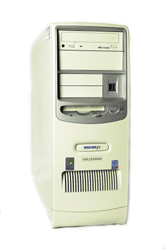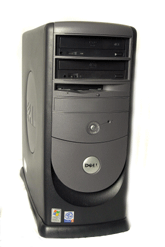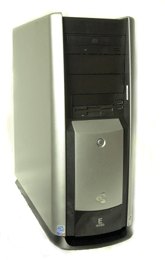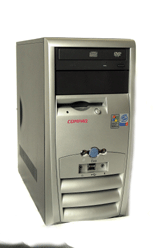Each year the GCN Lab takes a look at desktop clients with faster processors, bigger hard drives, and color and chassis updates. This year, vendors submitted five PCs sporting superfast Pentium 4 processors, 512M of RAM and top-end graphics cards.Using our benchmark suite from Alterion Corp. of Conshohocken, Pa., we sifted through all the factors that affect the handling of graphics- and processor-intensive applications.Although our benchmark suite measures graphical and memory performance, transfer rate consistency and processor speed, a good PC is more than just numbers.A spacious and well-designed chassis extends PC life, not only by making it easier for the administrator to upgrade but also by circulating air to ventilate the components.We looked for toolless opening, easy-to-reach RAM and optical drives, and an uncluttered interior with tangle-free wires. All those factors, coupled with price and extra features, determined the overall grades.Although our benchmark suite measures graphical and memory performance, transfer rate consistency and processor speed, a good PC is more than just numbers.[IMGCAP(3)] We saw several firsts this time. After previously participating in GCN desktop roundups, MPC Computers Inc., formerly MicronPC LLC of Nampa, Idaho, scored the highest grade, with an unprecedented 9,369 on the Alterion benchmark.The 3.07-GHz MPC Millennia 910i scored almost three times the 3,365-point average of our baseline PC, a 1.1-GHz Intel Celeron client with 256M of RAM.The Millennia 910i had a new tower design, 512M of double-data-rate synchronous dynamic RAM, an 80G Ultra ATA/100 hard drive capable of 7,200 revolutions per second and a 48/12/48X CD-rewritable drive. It incorporated one of the fastest processors in the review as well as one of the best-performing graphics cards'the nVidia GeForce4 Ti 4600.The Ti 4600's extra 128M of DDR memory smoothly processed intensive operations at a prodigious 1.23 trillion operations per second and a bandwidth of 10.4 gigabytes per second. That's 4G to 8G more than the video cards in the Compaq Computer Corp. and Sony Electronics Inc. model could deliver.Although the Dell Computer Corp. and Gateway Inc. machines matched the Millennia's video specifications, their slower processors brought down their averages.The Millennia 910i has a new chassis design, but we reviewed it in the older form factor. Even so, its toolless entry and spacious interior gave easy access to RAM, and its seven PCI card slots'the most of any chassis in the review'left room for lots of upgrades.Moderately priced at $1,923, the 910i was a workhorse bargain and a Reviewer's Choice.Dell didn't win first place this year, but we weren't surprised to find that the Dell Dimension 4550 came in a close second.[IMGCAP(4)] The $1,737, 2.8-GHz client scored an above-average 8,353 on the benchmark, placing it 2,000 points ahead of the closest competitor. It boasted a 200G, 7,200-rpm hard drive with 8M of cache memory. A robust 128M ATI Radeon 9700 Pro graphics card lay under the somewhat awkward clamshell chassis, and the processor and card got a boost from a dual in-line memory module of 512M of DDR SDRAM with a 533-MHz bus transfer rate.Although the clamshell chassis was tough to get used to, it did have some advantages besides being fully toolless. We found plenty of elbow room to add or remove RAM in one of the two DIMM slots or to swap PC Cards among the four slots.Likewise, the optical drives' position made removal easy without reaching around behind them. Inserting new drives also was easier because gravity aided their placement. These amenities easily made the Dimension 4550 a Reviewer's Choice.If the lab gave a Most Improved award, the Sony Vaio Digital Studio RZ would have gotten it. Compared with last year's Vaio, this one was vastly improved. It had a reasonable price, although not the lowest. Furthermore, Sony's usual innovations appeared both inside and outside the box.Last year, it was close to impossible to do even simple maintenance inside the Vaio's cramped minitower. This year, however, wires were neatly bundled away in the corners for relatively easy access to RAM. And there was a free slot for expansion.Sony's drive bay access was truly innovative. The case didn't get any bigger on the inside, but Sony managed to bring the inside out.There wasn't enough space to pull the drive bays backward into the enclosure. Because the front didn't snap off, they couldn't be pushed forward, either'the way most systems handle it.[IMGCAP(5)] So Sony moved to the sides. When we unlocked a metal holding pin, the entire enclosure for the optical and floppy drives slid sideways out of the case. A separate latch unlocked the hard drive.That design would give the administrator total freedom of movement to replace or add parts, and it counteracted the usual disadvantages of a small tower. The Vaio's small footprint gave plenty of room to work on components.As with most Sony products, there were some interesting extras unavailable elsewhere. On the front of the Vaio we found coaxial cable inputs. Scattered around the box were ports for Composite Video, S-Video, and six- and four-pin i-Link, plus six Universal Serial Bus 2.0 slots. The Vaio could even accept input from analog devices such as an 8mm camera. No other system in the review could match the Vaio's audio-visual compatibility.It also was the only system with a remote control and software to record or play live television. That made the Vaio a bit like a computer-VCR combo, which is unusual but pretty darn cool.The 120G Ultra ATA 7,200-rpm hard drive was big enough for video work. But in raw processing performance, the Vaio was the weakest of the bunch, scoring 6,338 on the benchmark. In view of its 4X Accelerated Graphics Port nVidia MX440 graphics card with 64M of video memory, that was a bit surprising. Nevertheless, the 2.66-GHz Pentium 4 processor with 533-MHz front-side bus was more than up for everyday computing with all the extras. In video editing, the system would be unequaled.The Gateway E-6000 was the largest desktop computer we have ever seen. It had nearly enough room inside the case to hold the Vaio.Large size meant little difficulty getting inside the case to perform maintenance. We removed one thumbscrew, and the side panel popped off easily. We could get at almost any component'drives, memory or cards'without any tools other than fingers.There was a ton of room for expansion: seven drive bays, five full-length PCI slots, one AGP slot and six USB ports. Only one small square area inside the case remained empty.[IMGCAP(2)] The 2.66-GHz processor was speedy, but overall the Gateway did not perform as well as several others, scoring 6,773. That's respectable, but we puzzled over why it wasn't higher. The reason was probably Gateway's choice of memory.The 512K of RAM comprised two banks of Rambus dynamic RAM, which is slower and less robust than the DDR RAM in all the other systems. Although RDRAM was the standard just two years ago, DDR memory is rapidly replacing it.The E-6000 came with a 200G Ultra ATA drive and integrated 8M cache. Drive access times were amazingly fast considering how much storage was available. And the nVidia GeForce4 Ti 4600G graphics card had 128M of memory for exceptional performance.But the E-6000's hard drive and graphics card were both pulled down a bit by the memory. Also, the E-6000 was the most expensive unit in the review. If you need a system with nearly infinite expandability, however, it's your best choice.The Hewlett-Packard Compaq Evo D310 was rather like the Geo Metro of the computer world: You don't expect a lot of extras.The D310 was up to most tasks with a 6,672 benchmark score. It scored lower than every other system except the Sony, however, and its 3.06-GHz Pentium 4 processor should have done better.The Compaq minitower held a jungle of wires and cables that complicated even small tasks such as adding memory. Also, we needed tools for some tasks, such as removing or adding PCI cards. The tangled mass made us nostalgic for the beautifully designed old HP Vectra series, which was discontinued after the Compaq-HP merger.The D310 should be adequate for most high-end applications, and its low price compared with the other systems in the review made it a good choice for tight budgets. It earned our Bang for the Buck designation.The MPC and Dell machines came out on top by achieving the highest performance at moderate cost. But, more important, they demonstrated that what's put into a computer will be only as good as how and where it's placed.
Millennia 910i
Henrik G.de Gyor
Dimension 4550
Henrik G.de Gyor
Vaio Digital Studio RZ
Henrik G.de Gyor










